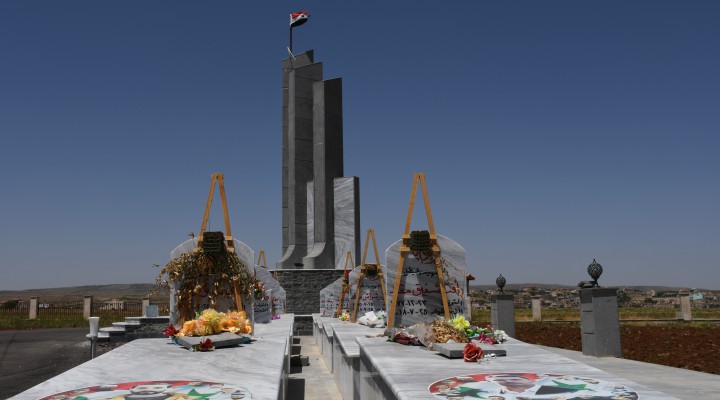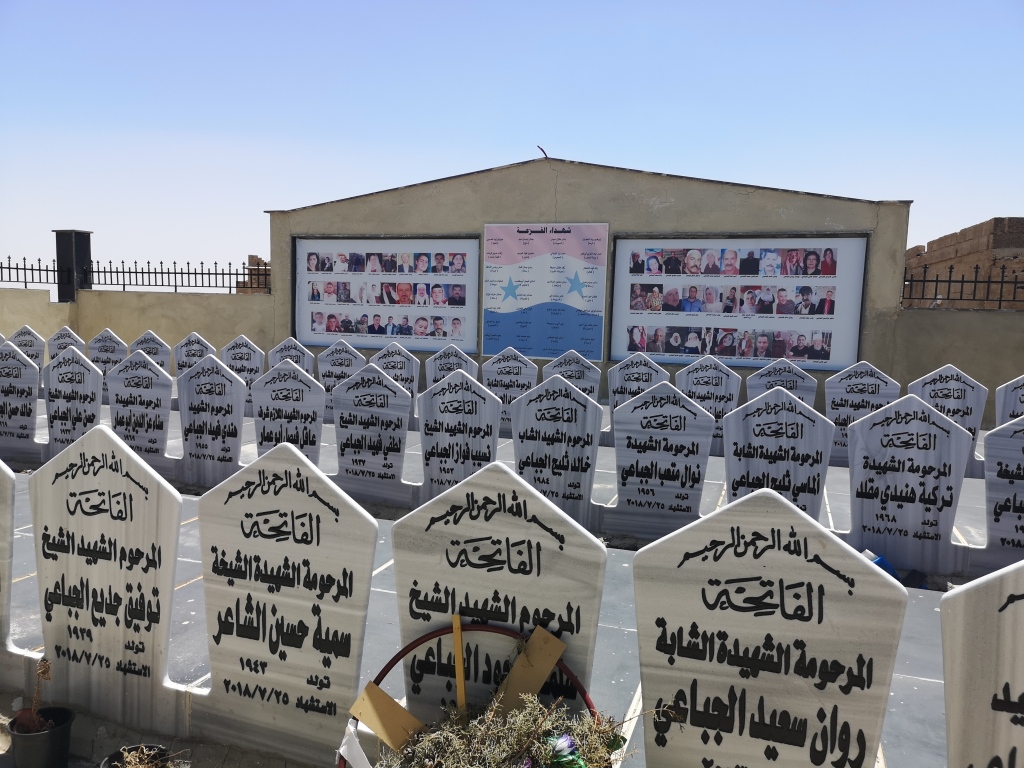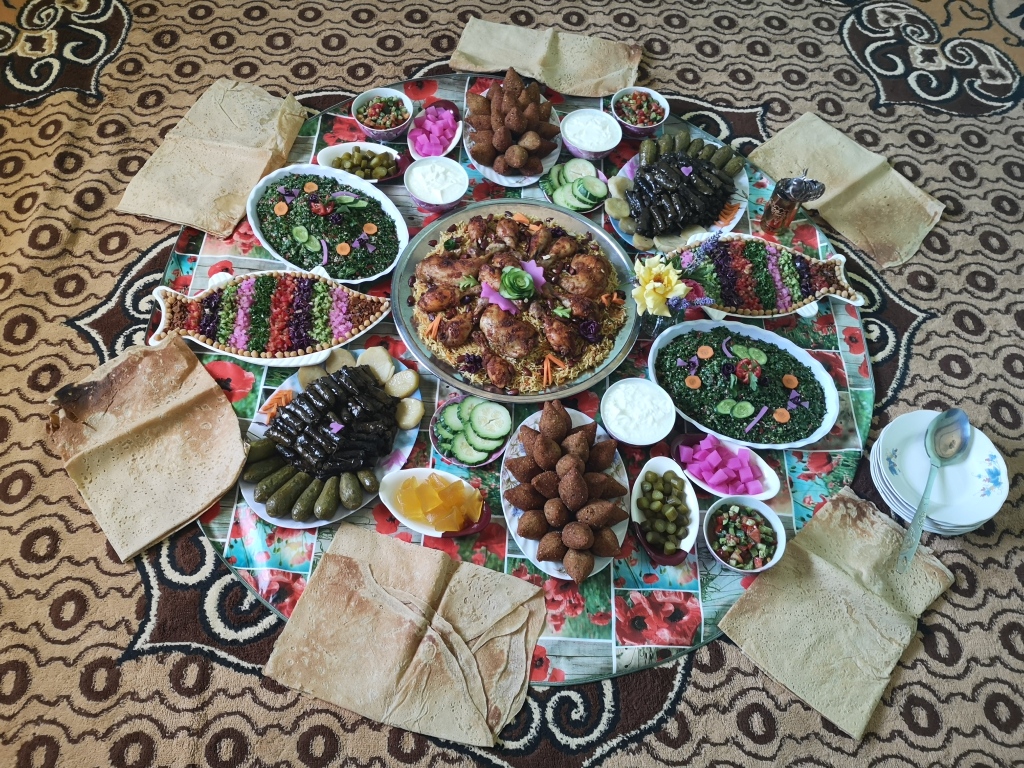Remembering Sweida – the ISIS massacre July 25th 2018

In 25 days, the people of Sweida in southern Syria will remember the bloody events that took place two years ago in Sweida City and the eastern countryside – the beautiful villages of Shbeki and Shrehi.

The gravestone of 14 year old Qussai, killed during the Syrian Arab Army resuce operation to bring back the women and children kidnapped by ISIS during the attack.
These people have rebuilt their lives painfully and slowly. The newly built memorial statues and gravestones at the entrance to each village are a stark reminder of how many innocent lives were taken the morning of the 25th June 2018, when ISIS terrorists entered the villages at 4am and began to slaughter children, women and elderly civilians as they lay sleeping.
The US sponsorship of this attack and of ISIS generally has been described many times by the survivors of this attack and the family members who have now returned to rebuild the shattered lives of these brave people.
I visited these villages only a few days after the ISIS attacks and I followed the case of the women and children, kidnapped by the terrorists as they fled eastwards towards the protection of the criminal US military base in Al Tanf.
I interviewed many of the survivors and the brave resistance fighters from the communities who described their terrifying battles with the heavily armed and well-equipped ISIS forces.
****
The graves at the entrance to Shrehi June 2020. (Photo: Vanessa Beeley)
For Mint Press News – The ISIS massacre in Sweida, a story of torment and resilience for an uninterested world.
“At 4 a.m. the terrorist group approached under cover of darkness. They encircled each village, posting snipers around the villages and along the straight road that connects them all, to prevent civilians from leaving or coming to the aid of others. ISIS fighters entered homes and murdered civilians — even children as they slept, unaware of the horror that was approaching. In Shbeki a disabled child was beheaded as he slept. In Shrehi “the roads ran with blood,” according to resident of the village, H. Saab (his full name is not given for security reasons), who lost 35 members of his extended family in the attack.”
https://www.mintpressnews.com/isis-massacre-sweida-syria…/…/
****
Interview with a young man who, with his comrades, engaged the ISIS terrorists and defended his people:
****

Interview with an elderly lady who managed to protect herself and her pregnant daughter in law when the terrorists invaded:
*****

Graves at the entrance to Shbeki – June 2020 (Photo: Vanessa Beeley)
July 2019 – Revisiting Shbeki and Shrehi.
During this visit I met with Ra’ed Fadel Abu Ammar whose parents had been murdered by the ISIS terrorists – his sister Tharwat was kidnapped and then executed on October 2nd 2018.
In this short interview Ra’ed describes the mental and emotional trauma that he suffered after these tragic, horrific events that ripped his family apart – events that were enabled and supported by the U.S Coalition and barely mentioned in Western media.
Ra’ed is a strong soul with a depth of emotion that is found within every Syrian who has endured this 8 year war waged against them. His words are simple but they convey the power of his trauma and the profound loss and shock that he is still experiencing. It was not easy for him to talk to me and I thank him for his trust and for opening his heart, still raw with grief.
“We believe that every human’s life has a start and an end. and the martyrdom of our families defending the land and dignity is honorable.
Tharwat was murdered, they murdered her. Our hearts were breaking, first over our family members – who were martyred and we put their bodies in the ground – and second, over our sister and our other sisters who were (abducted).
We say that “death is a glass that everyone will drink from”
Fadia’s testimony was an emotional journey through loss and trauma. She sat closer to the photo of Qussai and wept many times as she talked to me about the three months of ISIS brutality and abuse they endured.
When the attack began, Fadia had gathered her three children around her — Shahed, Qussai and Qais. They had stayed hidden in their home but ISIS knocked on their door demanding that the men be sent outside. Fadia had remained silent but she described how shots were fired at the house to drive them out. Fadia told me how the terrorists would go to a house and drag civilians onto the street, these civilians would be forced, at gunpoint, to knock at a neighbors house to entice them outside.
Fadia explained how this ruse was used to deceive them also:
When my brother-in-law’s wife came and I heard her voice ‘open the door, don’t be afraid, we want to go to the neighborhood’ and things like that. Of course, I didn’t open the door immediately; I waited because I didn’t want to open the door even if it became safe I didn’t want to go out of the house. My oldest son said ‘No mum, this is my uncle’s wife, probably everything is fine, we want to go to the neighborhood.’ So we opened the door and they [ISIS] said, ‘We want to take you to the school for about an hour then we will bring you back because we want to comb the houses.’”
Fadia was subsequently used by ISIS to persuade other family members to join their group as ISIS moved them towards an agricultural unit. Their mobile phones were taken from them. Initially, the ISIS fighters were claiming they would be held for a short time and then allowed to return home, but the mood changed when it was decided that Fadia and the others would be more useful as hostages, as bargaining chips in negotiations with the SAA and the Syrian government. They were moved out of the village towards Tilal Al-Safa:
They took us to the east of the village for about 15 minutes and after that they took us down to the valleys. We walked for about 10 or 11 hours without water, food or anything, and there were kids, a pregnant woman and old women with us.”
Haltingly, Fadia described the abuse hurled at them by the ISIS fighters: “Of course, they used bad words, ‘you are Kuffar [disbelievers], you are impure’ and things like that.”
Some of the hostages were isolated early on: “They isolated the Martyr Mohannad, the Martyr Qussai, Yaarub and Rajwan, they put them in a tent next to us. They took them, blindfolded their eyes and put them in a tent next to us.”
Fadia described how they were moved from place to place, staying in the first cave for six days before moving on to a different area where they were forced to shelter in a craggy, narrow ravine in the volcanic landscape. They were fed and given water intermittently, the first water they were given “tasted like diesel fuel.” While the adults, mostly women, were subjected to verbal humiliation, the children received beatings and physical abuse:
We went through all kinds of torment; we were starved and deprived of water, they humiliated the kids in front of us and beat them. For us, we were only humiliated by words — ‘you are defectors, you are impure’ — but the kids, they beat them and humiliated them. When they brought water for us we used to send the kids to bring water, there were children with us, one of them was a two-and-a-half-year old baby girl. The kids would go and ask for water, then they would be beaten and come back — Yaarub, Rajwan and Qussai.”
As the SAA advanced, ISIS would move the hostages deeper into the desert. At one point, Fadia told me they were marching for six days straight. The hostages were given one glass of water per day to be shared among three people and two dates for each hostage. For three days, they were given nothing. When the gunfire drew closer, the terrorists would taunt the children and the mothers by saying they would take the children towards the SAA positions and dig a grave for them so when they were shot, they would fall into the grave.
Fadia remembered the day of their liberation. Qussai had gone to get some water for them in the direction of the fierce clashes between ISIS and the SAA that could be heard close by. Most of the hostages had taken shelter in one of the ISIS trucks but Fadia had crept under the truck and was sitting on the ground when Qussai returned with the water. She testified:
In these moments Qussai and Raafat got injured, I came after hearing my sister shouting ‘Woe to you . . . O Qussai . . . come and see your son.’ I got into the truck and saw that my dear was injured but — thank God — he was still alive and fully conscious. He admonished me ‘Mum, why hadn’t you gotten into the car? Why are you still down there?’ and ‘Mum, what happened to my eye?’
Fadia tried to reassure her young son. The SAA soldiers approached the truck and told the hostages they were safe. Fadia begged one of the soldiers to please take care of her son, Qussai. Shortly after, an ambulance arrived and Qussai was given emergency treatment for his injuries.
We arrived to Palmyra hospital, they told us that Raafat was martyred and that Qussai’s situation is critical and they are going to send him to the military hospital in Homs. So we took him to the military hospital in Homs and an hour or [maybe] 15 minutes after we arrived they told us that he was martyred.”
Fadia’s final words to me were those of a proud and heartbroken mother who had endured horrific trauma and, at the moment of liberation, had been forced to watch her precious child’s life ebb away before her eyes:
Qussai made me feel like it was not a 14-years-old kid who was with me; he made feel that he was a man, a real hero in every sense of the word. He was honest with everyone, he was affectionate with everyone. Praise be to God for His grace, praise be to God. Our God loves him. He took him to His side. Our God loves him and granted him martyrdom and honor.”
****

Amazing Sweida/Syrian hospitality. Vanessa Beeley June 2020
“We defended our land and our homes because this land is mixed with the blood of generations of our people. We will not accept that people without morals or humanity can touch this land. We stay, we will stand and defend this land until we die. Our youth killed these terrorists even though they had very old weapons, very simple weapons. The ISIS fighters had modern, expensive equipment but we still defeated them.” said Khaled.
“Many of our young men, women and children bled to death in the street. Nobody was able to get to them or to transport them to hospital. If they tried they would be sniped.” Khaled told us.
“These groups, all of them, are supported by the UK, US and Gulf States to target and destroy our peaceful towns. Throughout history Syria has sacrificed martyrs and we are ready to sacrifice our souls for our land despite more than 120 countries attacking us with the terrorist groups as their instrument. They should know we will stand and fight to defend our land and our people”
****
 TheAltWorld
TheAltWorld 
0 thoughts on “Remembering Sweida – the ISIS massacre July 25th 2018”